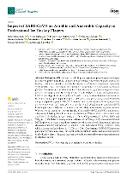Impact of SARS-CoV-2 on Aerobic and Anaerobic Capacity in Professional Ice Hockey Players

Autor
Roczniok, Robert
Terbalyan, Artur
Pietraszewski, Przemyslaw
Mikrut, Grzegorz
Zielonka, Hanna
Swinarew, Andrzej
Manilewska, Daria
Ornowski, Kajetan
Jablonski, Tomasz
Lipinska, Patrycja
Datum vydání
2025Publikováno v
Journal of Clinical MedicineRočník / Číslo vydání
14 (10)ISBN / ISSN
ISSN: 2077-0383ISBN / ISSN
eISSN: 2077-0383Metadata
Zobrazit celý záznamKolekce
Tato publikace má vydavatelskou verzi s DOI 10.3390/jcm14103478
Abstrakt
Background/Objectives: COVID-19 poses significant physiological challenges for athletes, particularly those engaged in high-intensity intermittent sports such as ice hockey. This study aimed to evaluate the impact of SARS-CoV-2 infection-especially symptomatic cases-on aerobic and anaerobic performance in professional ice hockey players. Methods: Fifty athletes from the Polish Hockey League were assigned to three groups: control (CG, n = 13), asymptomatic COVID-19 (NSG, n = 28), and symptomatic COVID-19 with post-infection SpO(2) < 90% (WSG, n = 9). Each underwent assessments at three time points-pre-preparatory period 2020/2021, post-preparatory period 2020/2021, and pre-preparatory period 2021/2022. Aerobic capacity was measured via a progressive cycle ergometer test (VO(2)max, VO2 at lactate threshold [VO2Lt], minute ventilation [V'E], breathing frequency [BF], and lactate clearance rate [Delta La]), and anaerobic capacity via a 30 s Wingate test (relative mean power). Results: Compared with CG and NSG, symptomatic athletes exhibited significant post-infection declines in VO(2)max (48.2 +/- 2.9 vs. 56.2 +/- 6.2 and 54.6 +/- 3.9 mL/kg/min; p = 0.006, d = 1.56 vs. CG; p < 0.024, d = 1.79 vs. NSG) and VO2Lt (p < 0.05). Relative mean power also decreased in WSG (p < 0.05). In contrast, CG and NSG improved or maintained these metrics over the same period. Symptomatic players showed elevated BF post infection (p = 0.022, d = 1.72) and reduced V'E (p = 0.035; d = 0.83), while Delta La was markedly lower (p = 0.0004; d = 2.86). Conclusions: SARS-CoV-2 infection, particularly symptomatic cases, can significantly impair both aerobic and anaerobic capacity in elite hockey players. Targeted recovery protocols are essential for restoring performance in affected athletes.
Klíčová slova
COVID-19, aerobic capacity, anaerobic capacity, ice hockey,
Trvalý odkaz
https://hdl.handle.net/20.500.14178/3107Licence
Licence pro užití plného textu výsledku: Creative Commons Uveďte původ 4.0 International







